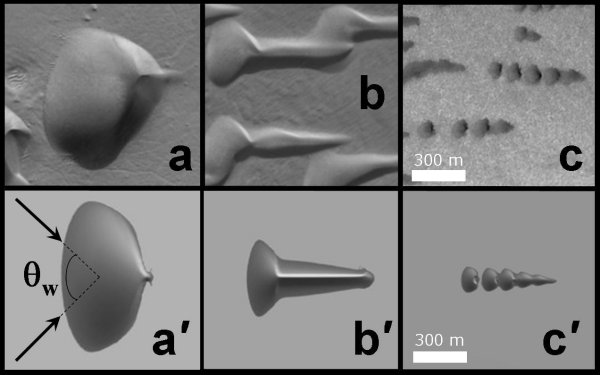Physicists may have solved a long-standing mystery about sand dunes on Mars. The dunes looks as if they should have been created by the action of wind, but the Martian atmosphere is so still and thin that it was thought impossible for wind to have played a part. New computer simulations suggest that the wind can indeed drive the sand dunes on Mars -- it's just that the dunes are formed far more slowly than back on Earth (Phys. Rev. Lett. 98 198001).

Astronomers have long been puzzled by the sand dunes on Mars, which were first discovered in 1971. The dunes look very much like those on Earth, which suggests they were created by the action of wind. The problem is that the Martian atmosphere is so thin and still — so how could the wind have played a part?
Even more curious is the fact that successive missions to Mars have not detected any change in the positions of the dunes, whereas the dunes on Earth are shifting constantly. Some scientists have therefore suggested that the dunes were created long ago, when the Martian atmosphere could have been much denser than it is today.
Now, however, Eric Parteli at the University of Stuttgart and Hans Herrmann at the Swiss Federal Institute of Technology in Zürich reckon the Martian dunes could indeed form and shift under the planet’s current atmospheric conditions. They have carried out a series of computer simulations of the formation of two distinct types of dunes seen on Mars — arrowhead-shaped “barchan” dunes, which are formed when the wind blows mainly in one direction, and elongated “exotic” dunes that are formed when the wind alternates between two directions (see figures).
Assuming that the sand was subject to just one 40-second gust of wind every five years – conditions experienced by Mars probes — the simulations suggested that the exotic dunes could have formed from barchan dunes over a period of about 10,000 to 50,000 years. Parteli told Physics Web that under the same conditions, it would take about 4000 years for a dune to shift by 1 m, which could explain why the dunes have not appeared to move since they were first discovered.
According to Parteli, the key to modelling the dunes is a process called “saltation”, whereby a grain of sand is lifted by the wind, and driven along above the sand until it falls back, creating a splash of ejected grains. The ejected grains could then also be picked up by the wind leading to a rapid multiplication of the amount of sand that is being blown along.
Saltation has been successfully modelled for dunes on Earth using parameters determined experimentally. But when Parteli and Herrmann used the same parameters under Martian conditions, they found that dunes would not form. Undeterred, they turned to research done nearly 30 years ago that established that the airborne grains should travel 10 times faster on Mars than on Earth thanks to the planet’s thinner atmosphere and lower gravity. As a result, each Martian grain should eject about ten times more sand upon impact than does a grain on Earth. Using these saltation parameters, Parteli and Herrmann were able to reproduce both the barchan and exotic dunes.
According to Parteli, the simulations suggest that atmospheric conditions on Mars have been relatively stable over the past 50,000 years and that the dunes are not necessarily evidence that the Martian atmosphere had been more Earth-like in the past.




